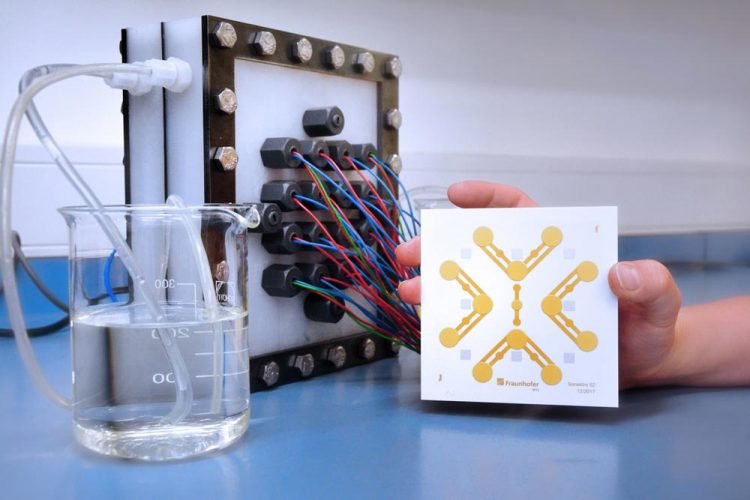Waste water without pharmaceutical residues – New process completely eliminates trace substances

© Fraunhofer IKTS Processing module with integrated ultrasonic sensors for complete removal of pharmaceutical residues.
In Germany, approximately 38,000 tons of medicines, including hormones, antibiotics and antivirals, are consumed annually. Their residues are increasingly found in the waste water of conurbations. From there they also enter ground- and surface water.
Ususally they are difficult to remove with conventional sewage plant and water treatment technology. Two very worrying trends are associated with this: the increasing of both the spread of multiresistant microorganisms and fertility disorders.
With the help of electrochemical processes, pharmaceutical residues can be completely degraded. They are electrochemically converted at the anode of an electrolysis cell, leaving only carbon dioxide. However, the anodes made of boron-doped diamond with a price of currently approx. 16,000 € per square meter are much too expensive. Fraunhofer IKTS is pursuing two approaches in order to manufacture the electrodes more cost-efficiently and increase the degradation rates.
Cost-efficient anode materials in combination with ultrasound
On the one hand, an alternative noble-metal-free anode material of semiconducting mixed-oxide phases was developed. Tin-antimony oxide-based systems have proven to be particularly effective. With the same functionality and service life, they cost only one tenth compared to boron-doped diamond.
On the other hand, researchers at Fraunhofer IKTS cause the waste water to oscillate by means of ultrasound in order to intensify the mass transport at the electrode and thus reach even higher degradation rates. This is achieved by minimizing the thickness of the diffusion layer on the anode. The layer acts as a kind of reaction barrier and thus slows down their destruction.
Ceramic-based electrode-sonotrode module
Not only the process combination is sophisticated, but also the design of the corresponding electrode-sonotrode module. The innovative approach consists of pressing the ultrasonic sensors directly onto the ceramic electrode so that it vibrates like a spring. This greatly improves material transport to the electrode. This is made possible by ceramic materials and technologies.
Fraunhofer IKTS covers the entire technological chain – from the development of functional materials, screen printing of ultrasonic actuators, suitable joining technologies for contacting the electrode to systems integration. In addition, there is extensive know-how in the field of electrochemical process engineering, which forms the basis for the successful treatment of polluted waste water. These intertwined competences of a research institute are unique in Europe.
On a laboratory scale, a convincing proof of the function of the new electrode-sonotrode module has recently been provided and a patent application has been filed. “In view of the positive results, we now see upscaling as a realistic goal. An electrochemical reactor is being developed and tested on a technical scale for this purpose,“ says Dipl.-Chem. Hans-Jürgen Friedrich, head of Technical Electrolysis and Geothermal Energy group at Fraunhofer IKTS in Dresden.
In the future, the electrode-sonotrode module will also be used in other sectors, such as the destruction of nitroaromatics, plasticizers, herbicide residues or other toxic substances in commercial waste water. “Applications in the field of chemical synthesis and sensor technology are also focused,“ adds project manager Hans-Jürgen Friedrich.
At this year‘s IFAT, Fraunhofer IKTS presents its entire portfolio of efficient and environmentally friendly water treatment technologies on Booth 132 in Hall A3.
https://www.ikts.fraunhofer.de/en/press_media/press_releases/waste_water_without…
https://www.ikts.fraunhofer.de/en/communication/trade_fairs/ifat_18.html
Media Contact
All latest news from the category: Life Sciences and Chemistry
Articles and reports from the Life Sciences and chemistry area deal with applied and basic research into modern biology, chemistry and human medicine.
Valuable information can be found on a range of life sciences fields including bacteriology, biochemistry, bionics, bioinformatics, biophysics, biotechnology, genetics, geobotany, human biology, marine biology, microbiology, molecular biology, cellular biology, zoology, bioinorganic chemistry, microchemistry and environmental chemistry.
Newest articles

Properties of new materials for microchips
… can now be measured well. Reseachers of Delft University of Technology demonstrated measuring performance properties of ultrathin silicon membranes. Making ever smaller and more powerful chips requires new ultrathin…

Floating solar’s potential
… to support sustainable development by addressing climate, water, and energy goals holistically. A new study published this week in Nature Energy raises the potential for floating solar photovoltaics (FPV)…

Skyrmions move at record speeds
… a step towards the computing of the future. An international research team led by scientists from the CNRS1 has discovered that the magnetic nanobubbles2 known as skyrmions can be…





















